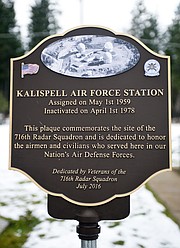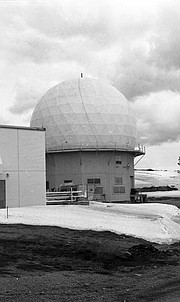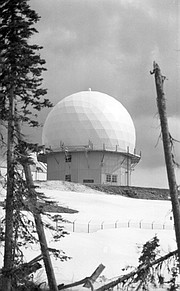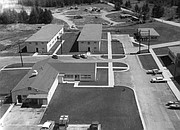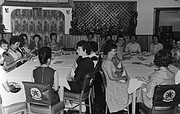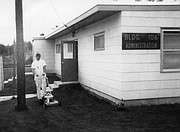Lakeside was once home to U.S. Air Force base
Tony Adrignola and Al Luna say they always get the same response when they tell people there used to be a U.S. Air Force base in Lakeside.
“There was an Air Force base here? In Lakeside?” is typically the reply.
“When I tell people this, they are amazed that we had a military base here,” Adrignola, of Rollins, said. “Back in the late ’50s, ’60s and mid-’70s we were an important part of the valley life … Lakeside was one of the choicest assignments.”
Adrignola, 86, liked the west lakeshore area of Flathead Lake so much he settled in Rollins after he retired from military service. In fact, he had acquired a place in Rollins two years before he retired.
Luna, a day shy of his 86th birthday, was wary of his assignment to Lakeside in the early ’60s, having spent time at an extremely remote Air Force base in Alaska. He arrived in early February with 18 inches of snow on the ground. He, too, learned to love the place and settled right in Lakeside where he and his wife raised a family and where they still reside. Luna came back to Lakeside a second time. After he was reassigned to Nebraska and that base eventually closed, he put in a request for Lakeside and got it.
“It was great, military-wise,” Luna said. “A guy looked forward to coming to a beautiful place like this.”
Both Adrignola and Luna were radar operators who worked with the base’s radar evaluation squadron.
Adrignola’s official title was an electronics warfare counter-countermeasures supervisor. “It was a specialized squadron,” he said. “As a team we went all over Canada evaluating radars.”
Remnants of the old base, located off Blacktail Road, are still there. The site has been used for decades by Youth With A Mission, a nonprofit Christian missionary organization.
Adrignola was the squadron historian, and when he left he scrawled a note on the back cover of an oversized scrapbook at the base.
“In the event of squadron closing or cutback, please don’t throw this book away, but contact Tony Adrignola for dispersal of contents. Thank you,” he wrote, including his phone number in Rollins.
And sure enough, he got a call one day after the base deactivated in 1978 to assume oversight of the base’s historical archive.
Plans for a radar station in Lakeside started in late 1955. It was formally designated as the Kalispell Air Force Station when the first property was acquired in 1957. Construction began in the spring of 1958.
The 716th Radar Squadron (Semi-Automatic Ground Environment, or SAGE) was activated at Geiger Field in Spokane, under the 25th Air Division (SAGE), McChord Air Force Base, Washington, and moved to Lakeside in June 1959, according to records in the squadron scrapbook.
In February 1960 the unit was reassigned to the 29th Air Division (SAGE), Malmstrom Air Force Base in Great Falls for operational and administrative control. Logistic control and support remained under the control of the 4700th Air Defense Wing at Geiger Field, squadron records indicate.
In laymen’s terms, the airmen stationed at Lakeside operated the radar facility on Blacktail Mountain around the clock during the height of the Cold War between the U.S. and Soviet bloc countries.
Many Flathead Valley longtime residents remember the three white dome-like structures atop the mountain that protected the delicate radar equipment from wind and harsh weather. An open house at the domes was held in October 1960 and drew a crowd of 1,200 spectators.
The Daily Inter Lake, tongue-in-cheek, called the domes a “triad of important mushrooms.”
The physical plant of Kalispell Air Force Station was divided into the upper operations site on Blacktail Mountain and a lower cantonment area in Lakeside that included the housing, administrative and support facilities for the troops and housing. The upper site housed the operations buildings, radar equipment and towers. A 15-mile access road connected the two areas.
Yellowed newspaper clippings in the scrapbook document the connection between the community and the base. One clip shows Sgt. Edward Cenkner in 1961 dressed as Santa Claus, handing out Christmas presents to children. The airmen sponsored a party at the radar station, complete with Christmas carols led by Mrs. William R. Ingram.
Another newspaper clipping features airmen from the Lakeside base marching in downtown Kalispell during the 1961 Veterans Day parade.
The scrapbook can vouch for Adrignola and Luna’s assertion that this was a plum spot for airmen to be stationed. In October 1960 John Forssen of the Daily Missoulian wrote a feature article titled “What’s This? A Pleasant Military Base.” His writing gushed about the modern facilities, tidy housing and well-kept streets throughout the base and how commercial dish-washing machines “have simplified life for the KPs.
“This small radar station provides illustrations of the military’s determination to run things economically while at the same time providing pleasant conditions for the men,” Forssen wrote. “Nothing luxurious, but comfortable.
“As an example, even this 100-man contingent has a potato peeling machine. That’s right — the potatoes, a symbol of unpleasant military life for centuries — is no more.”
The airmen got their own bowling alley in 1961, the Daily Inter Lake reported.
The newspaper also published numerous photographs through the years of awards the squadron and its airmen received.
There were some lighter moments captured on film, too. In 1967 the Inter Lake published a photo of identical twins Don and Ron Ahrens of Jackson, Michigan, who had been assigned to the Lakeside base, with the caption, “This could be a drill sergeant’s nightmare.”
A 1970 Inter Lake photo shows Sgt. Ray Knotts with a six-pound rainbow trout he’d caught at Little Bitterroot Lake in February. “Effective today he is promoted from airman first class to sergeant — not that that has anything to do with his fishing prowess,” the newspaper reported.
During a heavy forest fire season in 1967 the Missoulian noted how a lightning-caused fire stopped just short of the radar station, sparing the precious equipment.
Servicemen’s wives played an important role in the community, too. The 716th Radar Wives Club hosted regular parties for residents of the County Hospital.
Over the years, the equipment at the station was upgraded or modified to improve the efficiency and accuracy of the information gathered by the radars. The squadron was inactivated in 1978 as part of the draw down of Aerospace Defense Command, and the radar station was turned over to the Federal Aviation Administration, becoming a Joint Surveillance System site.
Features editor Lynnette Hintze may be reached at 758-4421 or lhintze@dailyinterlake.com.










